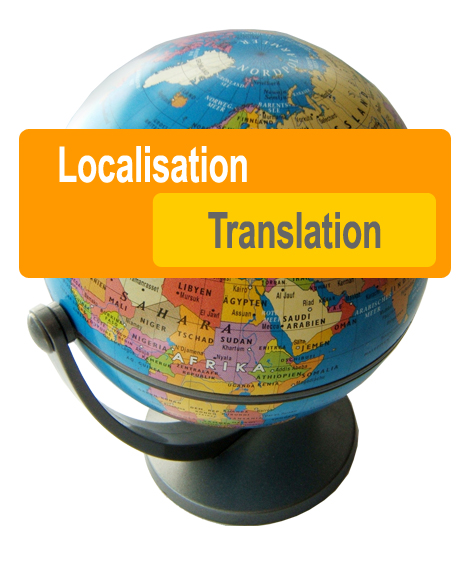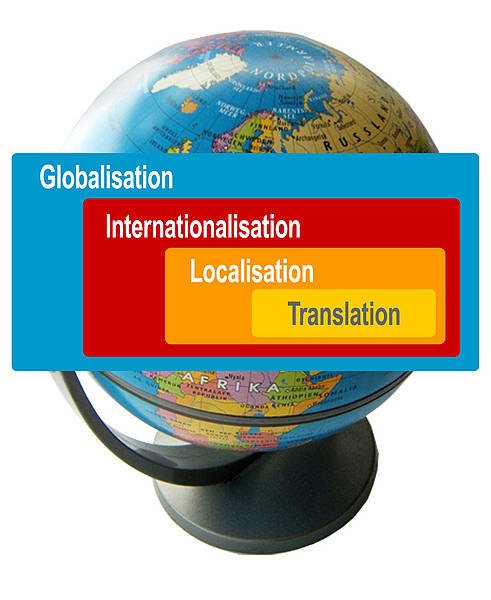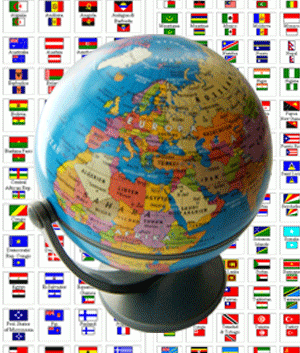"Globalisation addresses the business issues associated with taking a product global" (LISA, taken from Esselink, 2000:4). It refers to all activities related to the promotion of a (software) product on several regional markets (global marketing), taking into consideration economic and legal aspects.
For example, when a business wants to bring a product to the international market, it should first determine which technical, economic and legal conditions are required for such action. This is usually a task of the marketing or management department.
Globalisation is abbreviated to "G11N", "11" indicating the number of letters between "G" and "N" (cf. Esselink, 2000:4).
"Internationalisation is the process of generalizing a product so that it can handle multiple languages and cultural conventions without the need for re-design. Internationalisation takes place at the level of program design and document development" (LISA, taken from Esselink, 2000:2).
Internationalisation includes all activities during software development that allow easy adaptation of various language-specific features (called locales) and to other markets (languages and cultures).
Some of the common procedures used when developing software with aims of internationalizing it are the following:
- Separation of text and program code
- Display of different character sets (or use of UNICODE)
- Support of different keyboard layouts
Internationalisation is abbreviated to "I18N", "18" indicating the number of letters between "I" and "N" (cf. Esselink, 2000:4).
Localisation comprises all activities necessary for adapting a product to a specific locale, from translating to considering cultural contexts and target market needs. According to Esselink (2000:3), "Localisation involves taking a product and making it linguistically and culturally appropriate to the target locale where it will be used and sold".
Geographically speaking, a locale is defined as a location or region (e.g. the Italian speaking cantons of Switzerland). In the field of software localisation, a locale represents the set of information or code associated with a location or a region – e.g. character set, keyboard layout, text alignment, time, date, currency format, etc. (Schmitz, 2002:13).
Localisation is abbreviated to "L10N", "10" again indicating the number of letters between "L" and "N" (Esselink, 2000:3).
It is important to take into consideration that localisation and internationalisation:
- are both parts of their superordinated process globalisation
- are both part of the software development cycle, this means:
- both are product requirements
- both have to be specified
- both have to be designed
- both have to be implemented
- both have to be tested
- cost a fraction of a completely new development, e.g.:
- 50% of Microsoft's sales volume is made in non-English speaking countries
- certain products (e.g. medical devices) can only be brought to market if all components are localised
 Probably, you now might be asking yourself what would be then the difference between localisation and translation?
Probably, you now might be asking yourself what would be then the difference between localisation and translation?
Translation remains in the narrowest sense the conveyance of the source text from the source language in the target language.
Obviously, it can be assumed that a software product to be localised consists mainly of text or specialised text located in user interfaces (UI), menu options, error messages, online-help, etc. Though, there are economic, technical and organisational factors which normally are not considered when only translating, - e.g. adapting examples (business cards, scenarios), technical products (car, printer, connections), adaptation to satisfy laws and regulations (e.g. tax laws for financial software, medical software), etc. (cf. Schmitz, 2005:2-3).
"Translation is only one of the activities in localisation; in addition to translation, a localisation project includes many other tasks such as project management, software engineering, testing, and desktop publishing." (Esselink, 2000: 4)
L10N vs. translation
Today, from software localisation experience it can be stated that global marketing is only possible if products are adapted to regional markets. This means that globalisation and localisation belong together; therefore a new concept was created: Glocalisation.
Glocalisation refers to the trend towards global marketing of products and global adaptation of standards accompanied by an intensified return of local and regional particularities.






